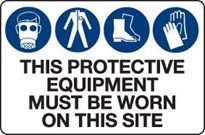The following terms are used in this document. The definitions below are used in the scope of this document, but local regulatory definitions supersede if there is a conflict.
Administrative areas: Areas within a Microsoft facility or construction site where the risk of injury is minimal, so that PPE is not necessary. Administrative areas typically include offices, corridors, conference rooms, restrooms, and breakrooms.
Administrative controls: The use of management involvement, employee training, job or task rotation, safe work practices, exposure monitoring, or medical surveillance to protect workers from exposures to workplace hazards.
Chemical-resistant gloves: Protective equipment worn over the hands as a barrier when there is a risk of chemical contact with hands. Gloves may be made of rubber, neoprene, nitrile, polyvinyl alcohol, vinyl, or other materials. When selecting chemical-resistant gloves, be sure to consult the manufacturers' recommendations for immersion and breakthrough.
Engineering controls: The elimination of a hazard by means of engineered machinery or equipment. Examples include process change, isolation, ventilation, and source modification.
Face shield: Normally consists of adjustable headgear and transparent barrier to protect the face from contact with chemical splashes or flying debris. The barrier may be constructed of tinted or transparent acetate or polycarbonate materials, or wire screen. Face shields are available in various sizes, tensile strength, impact or heat resistance, and light ray filtering capacity.
Goggles: Eye protection of soft pliable body design that prevents splash or vapor hazards from contacting the eye. They are available with clear or tinted lenses, perforated, port vented, or nonvented frames.
Hard hat: A lightweight protective helmet, usually of metal or reinforced plastic, worn by workers in industrial settings. A hard hat is a type of helmet predominately used in workplace environments such as construction sites to protect the head from injury, such as from falling objects.
Personal protective equipment (PPE): Specialized clothing or equipment worn by an employee for protection against workplace hazards. Examples include safety glasses or goggles, respirators, hard hats, hearing protection, gloves, impermeable or fire-retardant clothing, and protective boots.
Respirator: Any device, worn over the nose and mouth, designed to prevent the wearer from inhaling hazardous constituents present in ambient air.
Safety boots: Boots designed to protect feet from physical hazards.
Safety glasses: Protective eyeglasses made with safety frames, tempered glass or plastic lenses, and temples and side shields that provide eye protection from moderate impact and particles encountered in job tasks such as carpentry, woodworking, grinding, and scaling.
Steel-toed boots: Durable boots (sometimes safety boots and often with composite or ceramic toe boxes) made of leather or rubber with a reinforced toe to protect the foot against falling objects. They also often have steel inserts in their soles to prevent punctures from below.
Steel-reinforced safety shoes: Shoes designed to protect feet from common machinery hazards such as falling or rolling objects, cuts, and punctures. The entire toe box and insole are reinforced with steel, and the instep is protected by steel, aluminum, or plastic materials.
